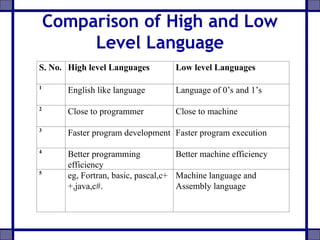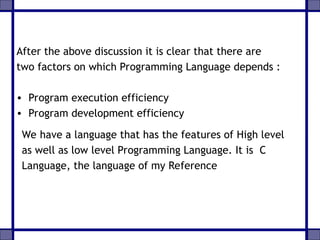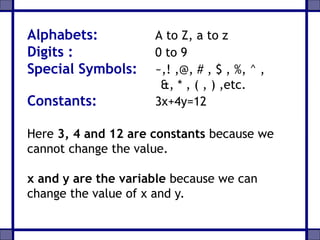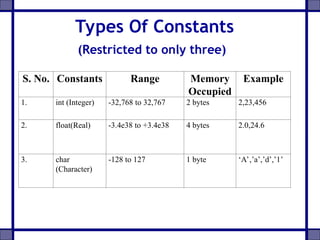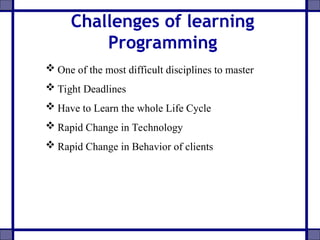Introduction to Programming with Reference to C programming
- 1. Fundamentals of Programming languages (With Reference to C Programming) Ashwani Kumar Assistant Professor PG Department of Computer Science Baring Union Christian College, Batala(Punjab)
- 2. Contents • Learning Outcome • Programming • Language • Programming Language • Types of Programming Languages • Basic concepts of C • Instructions & its types • Challenges of learning Programming
- 3. Learning Outcomes Student will able to Identify the problem Analyze the problem Find the possible solutions(Choose one) Develop the code Verify and Implement
- 4. What is Programming Language? Programming Language is a language in which we can write programs to solve some sort of problem. Here I have used the Word “program” , program is nothing ,it is just a group of instructions given to the computer for solving specific problem.
- 5. Types of Programming Languages Mainly we have two types of Programming Languages : 1 High level Programming Languages 2. Low level Programming Languages
- 6. Exercise
- 7. Comparison of High and Low Level Language S. No. High level Languages Low level Languages 1 English like language Language of 0’s and 1’s 2 Close to programmer Close to machine 3 Faster program development Faster program execution 4 Better programming efficiency Better machine efficiency 5 eg, Fortran, basic, pascal,c+ +,java,c#. Machine language and Assembly language
- 8. After the above discussion it is clear that there are two factors on which Programming Language depends : • Program execution efficiency • Program development efficiency We have a language that has the features of High level as well as low level Programming Language. It is C Language, the language of my Reference
- 9. Comparison of C with English ENGLISH C LANGUAGE Alphabets Alphabets, Digits & Special Symbols Words Constants, variable & Keywords Sentences Instructions Paragraph Programs
- 10. Alphabets: A to Z, a to z Digits : 0 to 9 Special Symbols: ~,! ,@, # , $ , %, ^ , &, * , ( , ) ,etc. Constants: 3x+4y=12 Here 3, 4 and 12 are constants because we cannot change the value. x and y are the variable because we can change the value of x and y.
- 11. S. No. Constants Range Memory Occupied Example 1. int (Integer) -32,768 to 32,767 2 bytes 2,23,456 2. float(Real) -3.4e38 to +3.4e38 4 bytes 2.0,24.6 3. char (Character) -128 to 127 1 byte ‘A’,’a’,’d’,’1’ Types Of Constants (Restricted to only three)
- 12. Variables , They are the name given to the location in the memory where different values are stored float rate_of_interest; int amount; Keywords , These are the words whose meaning is already known to the Compiler. There are 32 keywords used in C language int, char, void , for, if, else, do, switch, main, etc.
- 13. Instruction It is a statement which consists of variable, constants, special symbols and keywords. There are four types of instructions in C: 1. Type Declaration Instruction 2. Input/output Instruction 3. Arithmetic Instruction 4. Control Instruction
- 14. Type Declaration Instruction It is used to declare the variables in the program. Any variable in a C program must be declared before using it. These types of instruction must be written at the beginning of the program. int amount; char ch;
- 15. Input/output Instructions Input: These instructions are used to give input to the program Output: These Instructions are used to receive output from the program.
- 16. Arithmetic Instructions The instructions in which arithmetic operations can be performed are called arithmetic instructions. eg. rate_of_interest=(p*r*t)/100; •Arithmetic operation between integer and integer gives integer result. •Arithmetic operation between integer and float gives float result. • Arithmetic operation between float and float gives float result. Note: Operator and Operand For example 5/2 5.0/2 2/5 5.0/2.0 Answers: a) 2 b) 2.5 c) 0 d) 2.5
- 17. Arithmetic Instructions a) int c=5/2 b) float c=5/2 c) float c=2/5 d) int c=5.0/2.0 e) float c=9.0/2 f) float c=9/2.0 g) int c=9/2.0; Answers: a) 2 b) 2.0 c) 0.0 d) 2 e) 4.5 f) 4.5 g)4
- 18. Control Instructions S. No Instruction Type Use 1. Sequence Control Instruction Insure the sequential execution 2. Decision Control Instruction Allow the Compiler to take the decision, which instruction is to be executed next 3. Control Instruction Help the compiler to execute the no. of instruction repeatedly 4. Case Control Instruction Allow the Compiler to take the decision, which instruction is to be executed next
- 19. Rules for writing C program • All the statements are written in small case because C is case sensitive language. • Every program must be started from main function because C is a functional language and must have at least one function i.e main(). • To improve the readability, blank space must be inserted between two words. • Every statement ends with a semicolon(;). Some exceptions are there, I will explain where it needed.
- 20. So let’s start our first C program for explaining Sequence control instructions /* PROGRAM TO CALCULATE SIMPLE INTEREST*/ #include<conio.h> //HEADER FILE #include<stdio.h> main() { int p,t; //DECLARATION INSTRUCTIONS float r,si; //DI clrscr(); printf("Enter the values of p: "); //OUTPUT INSTRUCTION scanf("%d",&p); //INPUT INSTRUCTION printf("nEnter the values of r & t: "); scanf("%f%d",&r,&t); si=(p*r*t)/100; printf("nSimple interest is: %f",si); getch(); } OUTPUT IS AS FOLLOW: Enter the values of p: 100 Enter the values of r & t: 10 2 Simple interest is: 20.000000
- 21. DECISION CONTROL INSTRUCTIONS These instructions help the compiler to take decision which statements are to be executed next. There are three types of decision control instructions: 1. if eg. if(condition is true) execute this statement; 2. if else eg. if(condition is true) execute this statement; else execute this statement;
- 22. Working of if statement /*PROGRAM TO CALCULATE SIMPLE INTEREST USING IF*/ #include<conio.h> #include<stdio.h> main() { int p,t; float r,si,tds; clrscr(); p=1000; //DIRECT METHOD FOR INPUT t=2; r=10.0; si=p*r*t/100; if(si>100) { tds=si*10/100; si=si-tds; } printf("Net Simple Interest Is: %f",si); getch(); } OUTPUT IS AS FOLLOW: NET SIMPLE INTEREST IS: 180.000000
- 23. Working of if - else statement /* PROGRAM TO PRINT THE RESULT OF A STUDENT*/ #include<conio.h> #include<stdio.h> main() { int roll_no; float marks; printf("nENTER THE ROLL NO AND MARKS OF STUDENT: "); scanf("%d%f",&roll_no,&marks); if(marks>=40) printf("nStudent of roll no %d is pass",roll_no); else printf("nStudent of roll no %d is fail",roll_no); getch(); }
- 24. OUTPUT IS AS FOLLOW: ENTER THE ROLL NO AND MARKS OF STUDENT: 1100 56 Student of roll no 1100 is pass ENTER THE ROLL NO AND MARKS OF STUDENT: 1102 39 Student of roll no 1102 is fail
- 25. Word of caution int i=4; if(i=5) printf(“HELLO”); else printf(“HI”); int i=5; if(i=5) printf(“HELLO”); else printf(“HI”); int i=4; if(i= =5); printf(“HELLO”); printf(“nHI”); int i=4; if(i= =5) printf(“HELLO”); printf(“HI”); else printf(“GOOD”); HELL O ERROR HELLO HI HELLO
- 26. Let us consider the following problem to check our understanding about conditional statements “A company insures its driver in the following cases a) If the driver is married b) If the driver is unmarried , Male and above 30 years of age c) If the driver is unmarried ,Female and above 25 years of age” Here we have to take decision at 3 levels depending upon the following factors: 1. Marital status 2. Gender 3. Age
- 27. Loop control instructions There are three types of loops: 1. For loop 2. While loop 3. Do while loop Every loop control statement has three parts: 1. Initialization 2. Condition 3. Update
- 28. FLOW CHART OF SIMPLE INTEREST CALCULATION
- 29. The following example shows the working of For Loop /* PROGRAM TO CALCULATE SIMPLE INTEREST*/ #include<conio.h> #include<stdio.h> main() { int p,t,count; float r,si; clrscr(); for(count=1;count<=3;count++) //LOOP CONTROL INSTRUCTION OR FOR LOOP { printf("nEnter the values of p: "); scanf("%d",&p); printf("nEnter the values of r & t: "); scanf("%f%d",&r,&t); si=(p*r*t)/100; printf("nSimple interest is: %f",si); } getch(); }
- 30. ENTER THE VALUES OF P: 100 ENTER THE VALUES OF R & T: 2 2 SIMPLE INTEREST IS: 4.000000 ENTER THE VALUES OF P: 200 ENTER THE VALUES OF R & T: 2 2 SIMPLE INTEREST IS: 8.000000 ENTER THE VALUES OF P: 300 ENTER THE VALUES OF R & T: 2 5 SIMPLE INTEREST IS: 30.000000 Output for above program is as follow:
- 31. Challenges of learning Programming One of the most difficult disciplines to master Tight Deadlines Have to Learn the whole Life Cycle Rapid Change in Technology Rapid Change in Behavior of clients






